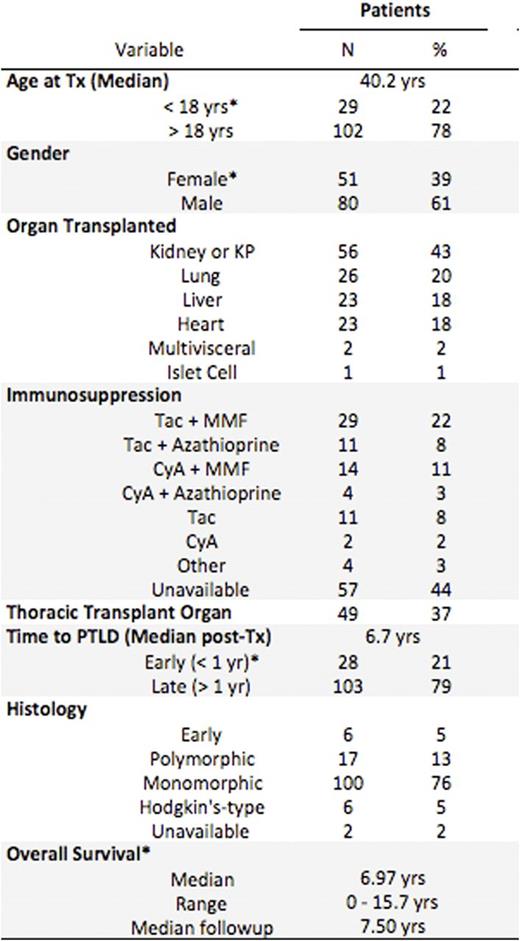Abstract
Introduction
The host immune status is central to both the pathogenesis and treatment of Post-Transplant Lymphoproliferative Disorders. (PTLD) The most commonly used prognostic model for PTLD, the International Prognostic Index (IPI), currently does not account for the effect of immune status on patient outcomes. We hypothesize that CD3 positive T-cell infiltrate density in the tumor microenvironment, thought to be a surrogate of the potency of the host versus tumor immune response, may be prognostic of overall survival in PTLD.
Methods
A database consisting of 131 biopsy confirmed PTLD cases occurring in pediatric and adult solid organ transplant recipients after the year 2000 in Alberta, Canada was analyzed for clinical prognostic variables and overall survival. CD3 infiltrate was determined by a blinded pathologist (JZ) using a standardized integer scoring system (0 - 3) to quantify CD3-positive cells in archived, formalin-fixed paraffin embedded tissue stained by immunohistochemistry. Tissue was available and assessed on a total of 72 patients. Survival analysis was done by Cox regression, with between group differences tested by a Pearson's chi-square test, with p < 0.05 being taken as significant.
Results
Median age at diagnosis was 40.2 years. Histology subtypes included early (n = 7), polymorphic (n = 17), monomorphic, (n = 100) Hodgkin, (n = 8) and unavailable. (n = 2) Immune suppression regimens at diagnosis included tacrolimus + mycophenolate (n = 29), tacrolimus + azathioprine (n = 11), cyclosporine + mycophenolate (n = 14), cyclosporine + azathioprine (n = 4), single agent tacrolimus (n = 11), single agent cyclosporine (n = 2), and other immunosuppressive regimens. (n = 4)
A denser CD3 T-cell infiltrate, defined as a CD3 score of 2-3, had a statistically significant protective effect by univariate Cox regression with respect to overall survival. (HR 0.352, p = 0.008) A CD3 score of 2-3 was negatively associated with a monomorphic histology (p < 0.001), but was not statistically associated with lymphocyte count, early PTLD, EBV status or bone marrow involvement. In the diffuse large B-cell type PTLD subgroup (n = 61) the association of a dense CD3 T-cell infiltrate with an improved OS was preserved. (HR 0.276, p = 0.041)
Clinical factors identified as significant by univariate Cox regression with respect to overall survival included age < 18 (HR = 0.380, p = 0.010), monomorphic histology (HR = 2.287, p = 0.02), IPI 3-5 (HR = 3.697, p < 0.001), BM involvement (HR 2.437, p = 0.008), and lymphocyte count < 1.0. (HR 2.449, p = 0.001) Clinical factors deemed to not be significant with respect to overall survival by univariate Cox regression included CD20 (p = 0.730), thoracic transplant organ (p = 0.314), PTLD onset within 1 year of transplant (p = 0.763), allograft involvement (p = 0.253), albumin of < 30 (p = 0.062) and tumor EBV status. (p = 0.278)
Multivariate Cox regression with respect to overall survival, including monomorphic histology, IPI 3-5, lymphocyte count < 1.0 and CD3 score of 2-3 again showed a statistically significant protective effect of a higher CD3 score. (HR 0.307, p = 0.022) No other clinical variables reached significance in the multivariate analysis.
Conclusions
A dense CD3 T-cell infiltrate in the tumor microenvironment at diagnosis is protective with regards to overall survival in PTLD by both univariate and multivariate Cox regression, versus traditional clinical prognostic markers. This is reflective of the prognostic importance of the host immune response, which can be altered by changes in exogenous immunosuppression. In the future, validated histologic measures of immune status such as the CD3 score may be integrated into existing models, such as the IPI, to provide additional prognostic power in PTLD.
Baseline Patient Characteristics - A database with 131 pediatric and adult solid organ transplant recipients with PTLD were analyzed for clinical prognostic factors and available formalin fixed paraffin embedded tissue stained for CD3 by immunohistochemistry.
Baseline Patient Characteristics - A database with 131 pediatric and adult solid organ transplant recipients with PTLD were analyzed for clinical prognostic factors and available formalin fixed paraffin embedded tissue stained for CD3 by immunohistochemistry.
CD3 Score by Univariate Analysis - A univariate Cox regression was carried out for a CD3 score of 2-3 versus 0-1 for all analyzed samples. (n = 72) * denotes the reference variable.
CD3 Score by Univariate Analysis - A univariate Cox regression was carried out for a CD3 score of 2-3 versus 0-1 for all analyzed samples. (n = 72) * denotes the reference variable.
CD3 score by Multivariate Analysis versus Clinical Factors - A multivariate Cox regression was performed for a CD3 score of 2-3, versus selected clinical factors identified by univariate Cox regression.
CD3 score by Multivariate Analysis versus Clinical Factors - A multivariate Cox regression was performed for a CD3 score of 2-3, versus selected clinical factors identified by univariate Cox regression.
Owen:Janssen: Honoraria; Gilead: Honoraria, Research Funding; Pharmacyclics: Research Funding; Celgene: Honoraria, Research Funding; Abbvie: Honoraria; Lundbeck: Honoraria, Research Funding; Novartis: Honoraria; Roche: Honoraria, Research Funding.
Author notes
Asterisk with author names denotes non-ASH members.




This feature is available to Subscribers Only
Sign In or Create an Account Close Modal